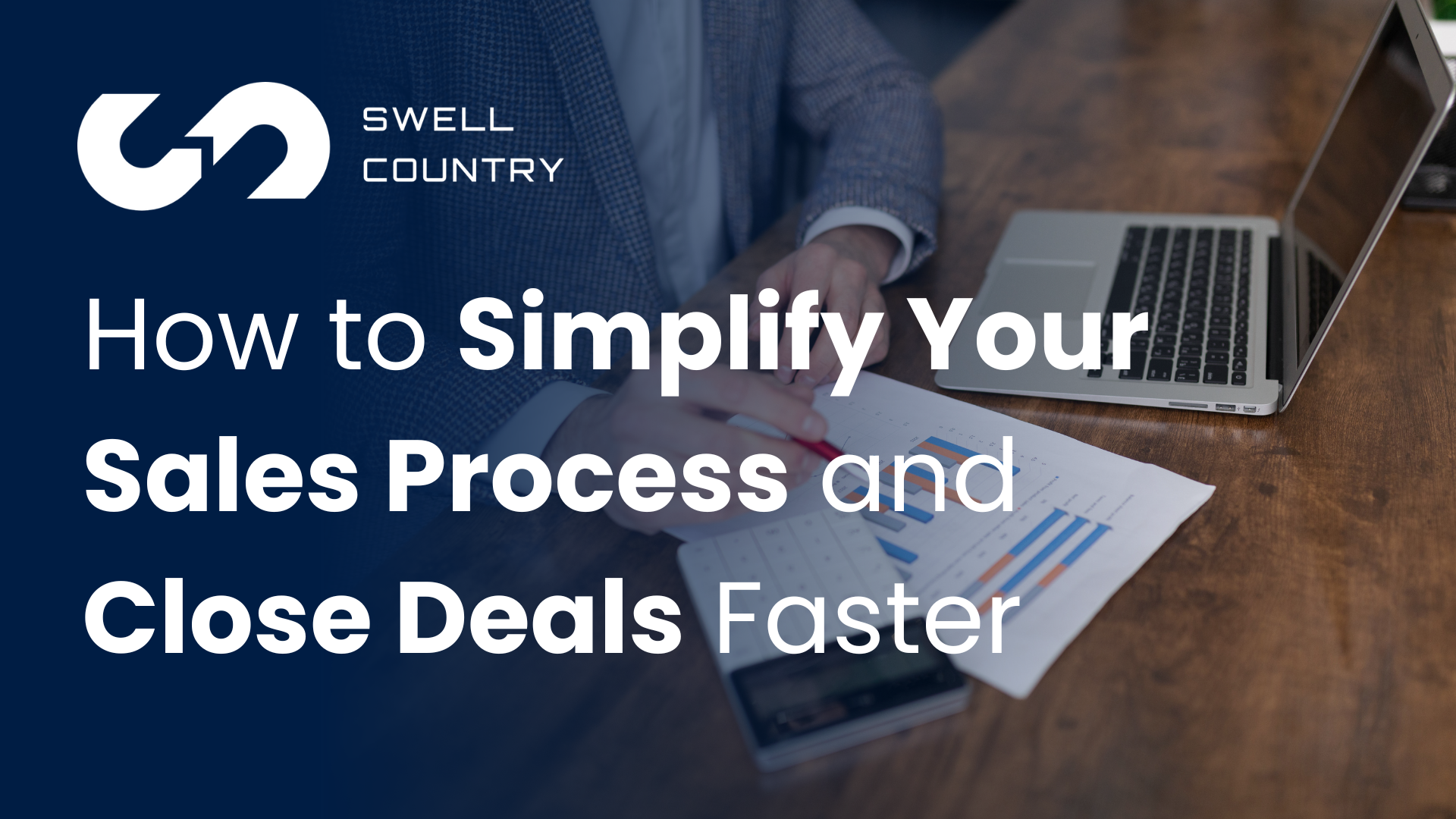A complicated sales process can slow down business growth, reduce efficiency, and result in missed opportunities. To close deals faster and improve sales performance, companies must streamline workflows, leverage digital marketing, and optimize conversion strategies. This guide explores proven techniques to enhance lead generation, refine customer acquisition tactics, and implement a growth strategy that ensures long-term success. Whether you're a startup or an established business, these insights will help you build a scalable, results-driven sales process that maximizes efficiency and revenue.
What This Blog Will Answer
-
What are the main challenges in simplifying the sales process?
-
How can businesses streamline workflows for better efficiency?
-
What role does digital marketing play in optimizing the sales process?
-
What tools and strategies can improve conversion optimization?
-
How can closing deals faster lead to long-term growth?
Understanding the Sales Process

The sales process is the structured journey that guides prospects from initial contact to a closed deal. It includes specific steps like identifying potential customers, nurturing relationships, and finalizing sales agreements. Many businesses struggle to simplify their sales processes due to complex workflows, redundant tasks, or poor communication between departments.
To streamline and optimize this journey, businesses need to focus on clarity, efficiency, and alignment between teams.
Common Challenges in the Sales Process
-
Inefficient Workflows: Disorganized workflows lead to wasted time and resources, decreasing team productivity.
-
Lack of Personalization: Treating all prospects the same without tailoring messaging to their needs reduces engagement.
-
Communication Gaps: Poor collaboration between marketing and sales teams can result in lost opportunities.
-
Low Conversion Rates: Without robust follow-ups and nurturing, leads are less likely to convert.
-
Lengthy Sales Cycles: Long and complex processes can lead to prospect disengagement.
The Components of a Sales Process
A successful sales process typically consists of:
-
Prospecting: Identifying potential customers who match your target audience.
-
Qualification: Evaluating leads to ensure they are a good fit for your product or service.
-
Presentation: Demonstrating the value of your offerings to address customer pain points.
-
Handling Objections: Effectively addressing customer concerns to build trust.
-
Closing: Finalizing the sale with clear agreements and next steps.
-
Follow-Up: Continuing engagement to maintain relationships and foster loyalty.
Each stage should be carefully optimized to ensure a seamless transition from one step to the next, supported by data-driven decisions.
Streamline Workflows for Better Efficiency
Efficiency is key to a successful sales process. Streamlining workflows not only saves time but also improves communication and decision-making within your team. An efficient workflow eliminates redundancies, standardizes procedures, and provides clear visibility into ongoing activities.
Steps to Streamline Workflows
-
Automate Repetitive Tasks: Use tools like HubSpot or Salesforce to automate lead assignment, follow-ups, and reporting tasks. Automation reduces manual errors and frees up valuable time.
-
Standardize Processes: Create standardized templates for proposals, emails, and presentations to save time and ensure consistency.
-
Integrate Technology: Use CRM systems that sync with marketing tools like email campaigns and social media platforms. Integrated systems provide a unified view of customer interactions.
-
Set Clear Goals: Define KPIs such as conversion rates, response times, and average deal value. Setting measurable targets provides a benchmark for evaluating success.
-
Analyze Data Regularly: Identify inefficiencies and optimize steps that slow down the process. Use analytics dashboards to monitor progress and adjust workflows as needed.
Tools for Workflow Management

-
Trello: Visualize workflows with simple drag-and-drop task boards.
-
Asana: Assign tasks and track progress with an intuitive interface.
-
Monday.com: Centralize all sales activities, ensuring accountability and transparency.
-
Slack: Enhance real-time team communication for quicker decision-making.
Experiential Component: Businesses using automation tools report a 20% increase in productivity on average. For instance, automating lead scoring enables sales reps to prioritize high-value prospects, resulting in faster closures.
Leveraging Digital Marketing for Sales Optimization
Digital marketing bridges the gap between potential customers and your sales team. By combining targeted campaigns with data-driven insights, digital marketing enhances the sales process and ensures consistent lead flow. Effective digital marketing strategies attract qualified prospects and guide them seamlessly through the sales funnel.
Key Digital Marketing Techniques
-
SEO (Search Engine Optimization): Drive organic traffic by optimizing web pages for high-ranking keywords.
-
PPC Campaigns: Generate immediate visibility through paid advertising platforms like Google Ads. Paid ads allow businesses to target specific demographics with precision.
-
Social Media Marketing: Build relationships with your audience on platforms like LinkedIn, Instagram, and Facebook. Regular updates and engagement foster trust.
-
Email Marketing: Nurture leads through personalized email sequences that guide them through the sales funnel. Emails tailored to user behavior increase open and click-through rates.
Integrating Digital Marketing with Sales
-
Unified Messaging: Collaborate with marketing teams to ensure campaigns align with sales goals. Consistent messaging reinforces brand identity.
-
Real-Time Data Sharing: Use shared dashboards to provide sales teams with instant updates on campaign performance. This improves lead tracking.
-
Content Personalization: Leverage customer data to tailor content based on their preferences and behaviors. Personalization boosts engagement and conversions.
External Resource: Learn more about improving marketing-sales alignment at Encyclopedia Britannica.
Tools and Strategies for Conversion Optimization
Conversion optimization is about refining your sales funnel to maximize the number of prospects who become paying customers. This process involves analyzing user behavior, optimizing user experiences, and implementing persuasive tactics to increase conversion rates.
Conversion Optimization Tactics
-
Heatmap Analysis: Tools like Crazy Egg show where users click most on your site, helping identify areas for improvement.
-
A/B Testing: Experiment with different versions of landing pages or CTAs to see which performs better. Small tweaks can lead to significant improvements.
-
Simplified Navigation: Ensure that your website is easy to navigate, reducing barriers to conversion. A clutter-free layout improves user satisfaction.
-
Compelling CTAs: Use phrases like "Schedule Your Free Demo Today" or "Claim Your Exclusive Offer" to encourage action.
-
Landing Page Optimization: Design pages that are visually appealing and highlight key value propositions clearly.
Example: A SaaS company increased signups by 30% after A/B testing its homepage headline to highlight ease of use instead of cost savings.
Using CRM Systems for Optimization

-
Enhanced Lead Tracking: Monitor the journey of each lead, ensuring no opportunities are missed.
-
Automated Follow-Ups: Schedule reminders and send timely notifications to stay connected with leads.
-
Customizable Dashboards: Track progress and measure ROI for ongoing campaigns.
-
Behavioral Insights: Analyze how leads interact with your communications to refine future strategies.
Closing Deals Faster for Long-Term Growth
Accelerating deal closures positively impacts cash flow, resource allocation, and customer satisfaction. A streamlined closing strategy not only benefits your sales team but also ensures prospects feel valued and understood.
Effective Strategies to Close Deals Faster
-
Focus on Pain Points: Address specific challenges prospects face and explain how your solution resolves them. Use storytelling to make solutions relatable.
-
Offer Limited-Time Discounts: Create urgency by providing time-sensitive offers. Include countdown timers on landing pages to reinforce scarcity.
-
Streamlined Contract Processes: Use e-signature platforms to expedite agreements. These platforms reduce friction and speed up decision-making.
-
Provide Post-Sale Support: Reassure customers by outlining next steps and follow-up plans. A dedicated account manager can build lasting trust.
Benefits of Faster Deal Closures
-
Improved Cash Flow: Faster deal completion ensures revenue cycles are shorter.
-
Increased Team Capacity: Allows sales teams to focus on acquiring new leads.
-
Higher Customer Retention: Builds trust through efficient and satisfying experiences.
-
Enhanced Competitive Edge: Quick response times and efficient processes set your business apart.
External Resource: Read about best practices for handling objections at Scholarpedia.
Key Takeaways
-
Streamlined workflows improve efficiency by automating repetitive tasks and fostering collaboration. Explore how.
-
Digital marketing enhances lead generation, ensuring steady sales opportunities. Learn more.
-
Conversion optimization refines the sales funnel, increasing customer acquisition rates. Discover strategies.
-
Faster deal closures reduce sales cycle times, improving resource allocation. See details.
-
Customer-centric approaches build trust, driving loyalty and repeat business.
Swell Country
Visit Us
Social Media Links
Follow us for more updates:








